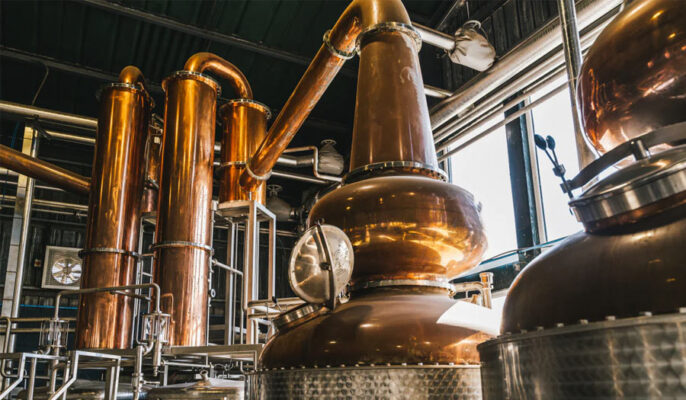위스키 증류소를 시작하는 것은 준비와 실행의 여러 측면을 포함하는 복잡한 작업입니다. 새로운 위스키 증류소를 설립하는 데 드는 비용은 사업 계획과 만들고자 하는 증류소의 유형과 규모에 따라 크게 달라집니다. 증류소 설립에는 상당한 초기 투자가 필요한 경우가 많으므로 처음부터 가능한 한 계획을 잘 세우는 것이 중요합니다.
위스키 증류소란 무엇인가요?
위스키 증류소는 위스키 생산을 전문으로 하는 시설 또는 사업체입니다. 위스키는 일반적으로 보리 또는 기타 곡물을 발효, 증류 및 숙성하여 만든 고전적인 증류주입니다. 위스키 증류소의 주요 활동에는 원료 조달 및 가공, 알코올 발효 및 증류, 주류의 숙성 및 숙성, 최종 제품의 포장 및 판매 등이 포함됩니다.
위스키 증류소의 주요 구성 요소:
- 매싱 장비: 여기에는 곡물을 뜨거운 물과 혼합하여 전분을 발효 가능한 당분으로 전환하는 '매싱 배럴'이라는 용기가 포함됩니다. 위스키 생산의 첫 번째 단계를 매싱이라고 합니다.
- 발효 탱크: 매싱 후 액체(맥아즙)는 다음 위치로 옮겨집니다. 발효 탱크에 효모를 첨가하여 당분을 알코올과 다양한 향료 화합물로 발효시킵니다.
- 증류기: 발효된 술(현재는 찌꺼기라고 부름)을 적절한 시간 동안 발효 및 숙성시킨 후, 생산되는 위스키 스타일에 따라 전통적인 포트 스틸 또는 연속식 칼럼 스틸을 사용하여 증류합니다.
- 숙성 창고: 위스키는 일반적으로 오크통에서 몇 년 동안 숙성되며, 숙성 과정을 통해 풍미, 색상 및 특성이 발달합니다.
- 보틀링 라인: 위스키가 숙성되면 병입 라인으로 이동하여 물로 특정 알코올 도수에 도달하도록 조정한 후 병에 담아 라벨을 부착하고 판매용으로 유통합니다.

위스키 증류소를 시작하는 단계
시장 조사 및 사업 계획
양조장을 시작하기 전에 먼저 시장 수요와 잠재적 경쟁을 평가하기 위해 시장 조사를 수행해야 합니다. 여기에는 다음이 포함됩니다:
- 타겟 시장 및 소비자 분석: 타겟 시장이 어떤 소비자 그룹인지, 그들의 선호도 및 구매 습관을 파악합니다.
- 경쟁 분석: 기존 위스키 브랜드와 시장 포지셔닝을 이해하고, 경쟁 우위와 포지셔닝 포인트를 찾아보세요.
- 사업 계획: 예산, 자본 요구 사항, 예상 수익, 마케팅 전략을 포함한 세부 사업 계획을 수립합니다.
양조장 라이선스 신청
증류소를 시작하려면 엄격한 법률과 규정을 준수해야 합니다. 위스키 증류소를 시작하려면 증류소 면허를 취득해야 합니다. 즉, 면허를 받은 주류 생산자가 되어 생산 신고서를 제출하고 생산한 각 주류 병에 대해 주세를 납부해야 합니다. 생산 시설이 건물, 건강 및 안전 기준을 충족하는지 확인하고 관련 승인 및 라이선스를 취득해야 합니다.
제품 결정
자신의 분야에서 최고가 되려면 술과 관련된 지식의 걸어 다니는 백과사전이 되어야 합니다. 가능한 한 많은 주류를 맛보고, 다른 양조장을 방문하고, 업계의 새로운 발전 동향을 주시하세요. 항상 실무와 비즈니스 모두에서 지식을 넓히기 위해 노력하세요.
- 새로운 브랜드와 커피를 정기적으로 마셔보는 습관을 기르세요. 내 제품과 다른 제품의 차이를 명확하게 표현하려면 많은 직접 경험을 쌓아야 합니다.
- 가능하면 증류주 축제와 특별 이벤트에 참석하세요. 이러한 행사에서는 다양한 수제 증류주를 판매하며 훌륭한 체험 학습 기회를 제공할 수 있습니다.
위치 선택
올바른 위치와 생산 시설을 선택하는 것은 성공적인 증류소를 시작하기 위한 중요한 단계입니다. 증류소를 위한 물리적 본사를 둘러보세요. 소규모 독립형 작업장, 창고 건물, 넓은 매장 등이 가능한 옵션입니다. 예상 창업 예산으로 부동산 임대료를 지불하고 증류 사업을 편안하게 운영할 수 있는 충분한 여유가 있는지 확인하세요.
구매 선택 증류 장비
위스키 증류 장비는 증류소의 핵심 부품으로 최종 제품의 맛과 품질에 직접적인 영향을 미칩니다. 증류 장비에는 포트 스틸과 컬럼 스틸의 두 가지 주요 유형이 있습니다.
냄비 스틸
팟 스틸은 발효 액체를 끓을 때까지 가열하는 발열체(보통 증기로 가열)가 있는 큰 항아리로 구성됩니다. 뜨거운 증기는 스틸의 상단으로 올라가고 콘덴서에 의해 냉각되어 베이스 스피릿이라는 액체가 됩니다. 포트 스틸은 증류 과정에서 위스키 특유의 풍미를 내는 맥아즙 향과 에스테르 화합물을 더 많이 함유할 수 있기 때문에 복잡하고 풍부한 맛을 제공할 수 있습니다.
열 스틸
칼럼은 수직으로 배열된 일련의 기둥으로 구성되며, 각 기둥은 내부에서 증기와 액체를 교환합니다. 이 장비는 다단계 증류 공정을 사용하여 서로 다른 컬럼에서 술을 여러 번 가열하고 냉각하여 서로 다른 알코올 함량을 분리합니다.
컬럼 스틸은 더 순수하고 농축된 알코올을 생산하며 일반적으로 포트 스틸보다 더 가볍고 깔끔한 맛을 냅니다.
재무 관리 및 비용 관리
예산과 현금 흐름을 관리하여 재무 안정성과 지속 가능성을 보장하는 효과적인 재무 관리 및 비용 관리는 와이너리의 성공적인 운영을 위한 기초입니다. 생산 비용과 판매 비용을 모니터링하고 효과적인 비용 관리 및 수익 분석을 수행하세요.
위스키 증류소를 시작하는 데 드는 비용은 얼마입니까?
위스키 증류소 사업이라면 마이크로 증류소를 시작하는 데 드는 비용은 얼마인가요? 간단히 말해, 일반 와이너리보다 훨씬 저렴합니다. 표준 와이너리는 더 많은 병을 생산하기 위해 더 많은 장비가 필요하기 때문에 비용이 훨씬 더 높습니다. 마이크로 와이너리는 소량의 와인만 생산하기 때문에 더 적은 장비가 필요합니다. 마찬가지로 초기 재료비도 저렴합니다. 위스키 증류소에 필요한 자금은 다양한 요인에 따라 달라집니다.
- 장비 비용: 증류 장비 이것은 증류소에 대한 가장 중요한 투자 중 하나입니다. 비용은 선택한 증류기의 유형, 장비 크기 및 건축 자재에 따라 달라집니다. 일반적인 증류 장비의 가격은 수십만 달러에서 수백만 달러에 달할 수 있습니다. 발효기 및 저장 배럴 용기는 와인 주류를 발효하고 숙성하는 데 사용됩니다. 비용은 재료, 크기, 수량에 따라 달라집니다.
- 생산 시설: 와이너리 건설, 장비 설치, 전력 배전, 수처리 장비 등을 포함합니다. 비용은 지역에 따라 다르지만 일반적으로 고가의 투자입니다.
- 원재료 비용: 주원료인 보리 및 기타 곡물의 구매 비용입니다. 효모와 물은 발효 과정에 필수적인 재료입니다.
- 법률 및 라이선스: 이러한 라이선스를 신청하고 유지하려면 상당한 자금과 시간이 필요할 수 있습니다.
- 운영 비용: 인건비에는 와인 메이커, 운영자, 영업 및 마케팅 담당자 등이 포함됩니다. 에너지 비용에는 전기, 가스 등이 포함됩니다.
- 포장 디자인 및 마케팅: 포장 디자인과 라벨 인쇄는 제품의 매력과 시장에서의 규정 준수를 보장합니다. 마케팅 비용에는 광고, 홍보, 전시회 참가 및 프로모션 등이 포함됩니다.
결론
위스키 증류소를 시작하는 데 드는 비용은 선택한 규모와 시장 포지셔닝에 따라 수백만 달러에서 수천만 달러까지 다양합니다. 미셋 그룹에 문의하실 수 있습니다. 저희 엔지니어들은 스타트업이 일련의 작업을 시작하기 전에 상세한 사업 계획과 예산을 개발할 것을 권장합니다. 맞춤형 서비스를 제공할 수 있습니다.




